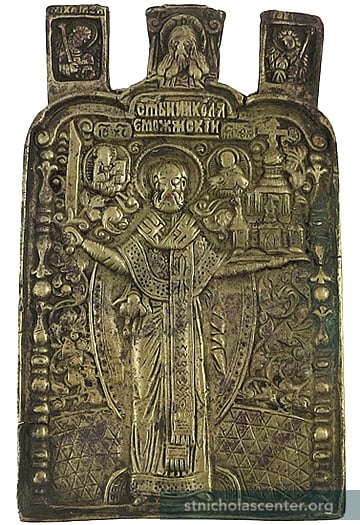Wonderworker

St. Nicholas Center Collection
St. Nicholas ~ Wonderworker
December 6 or 19 if on the Julian Calendar
In Myra you proved yourself to be a priest,a servant of divine things, O Saint,
for you fulfilled the Gospel of Christ, O holy one.
You gave up your life for your people
and saved the innocent from death.
You have been sanctified
for you were a great guide
towards the things of God.
—Kontakion of St. Nicholas
St. Nicholas followed the words of our Lord, to "lay up treasure for yourself in Heaven," by praying every day, by fasting, and by performing good deeds. God was so pleased that he worked many miracles through Nicholas. People began to call him a "wonderworker" (a person who works wonders or performs miracles). They were so inspired by his life of service to others that many of them, too, began to lead holy lives, filled with good deeds.
As a faithful bishop/shepherd, St. Nicholas was revered as a saint even before his death because of his great holiness and tender care of his flock. After the Blessed Mother and St. John the Forerunner (Baptist), Nicholas was the most revered saint in the early church. He is most honored in the East, especially in Russia. Throughout the world many churches are named for him—more than for any other saint. His ministry continues to this day as a powerful intercessor for the protection and advancement of the Church.
In the weekly liturgical cycle of the Orthodox Church, Thursday is dedicated to the Holy Apostles and to Saint Nicholas, who stands as a model for all the great hierarchs, the successors to the Apostles and teachers of the Church. To be given a place in the weekly cycle indicates the great veneration the Church accords him.*
Saint Nicholas the Wonderworker, Archbishop of Myra, December 6
from Saint of the Day, Ancient Faith Radio 4:10 minutes
Used by permission
Reflection on Icons of St. Nicholas
from The Prologue from Ohrid
St. Nicholas, Santa Claus, and the Nativity
An interview with Metropolitan Hilarion
More in other sections
Traditional Miracles
Modern Miracles
The Intercession of St. Nicholas in Our Days
Reflections by three Russian Orthodox priests
Writing a Saint Nicholas Icon
Reflections on the process, with pictures
Links
* The quite exceptional veneration of St. Nicholas is well known. In the liturgic weekly cycle of the Orthodox Church, among the days of the week dedicated to the Saviour and to different orders of heavenly and earthly sanctity, only three persons are singled out by name: the Mother of God, John the Forerunner and St. Nicholas. The reason for this special veneration of this bishop, who left neither theological works nor other writings, is evidently that the Church sees in him a personification of a shepherd, of its defender and intercessor. "Having fulfilled the Gospel of Christ . . . thou hast appeared in truth as a most hallowed shepherd to the world. According to his Life, when St. Nicholas was raised to the dignity of bishop he said: ". . . This dignity and this office demand different usage, in order that one should live no longer for oneself but for others." This "life for others" is his characteristic feature and is manifested by the great variety of forms of his solicitude for [people]—his care for their preservation, their protection from the elements, from human injustice, from heresies and so forth. This solicitude was accompanied by numerous miracles both during his life and after his death. Indefatigable intercessor, steadfast, uncompromising fighter for Orthodoxy, "he was meek and gentle in his disposition and humble in spirit".
Léonide Ouspensky & Vladimir Lossky, The Meaning of Icons, 2nd edition, St Vladimir's Seminary Press, 1982.
Adapted from:
Orthodox America and
St. Therese Byzantine Catholic Church, St. Petersburg, Florida


